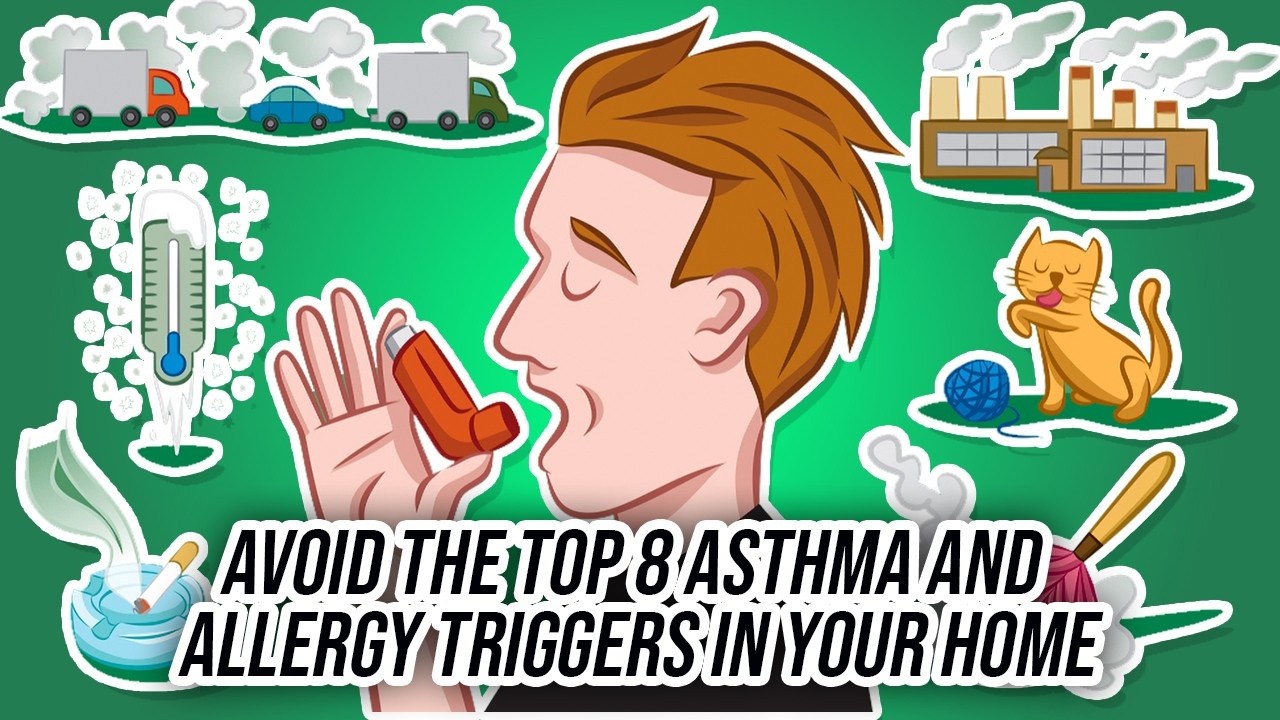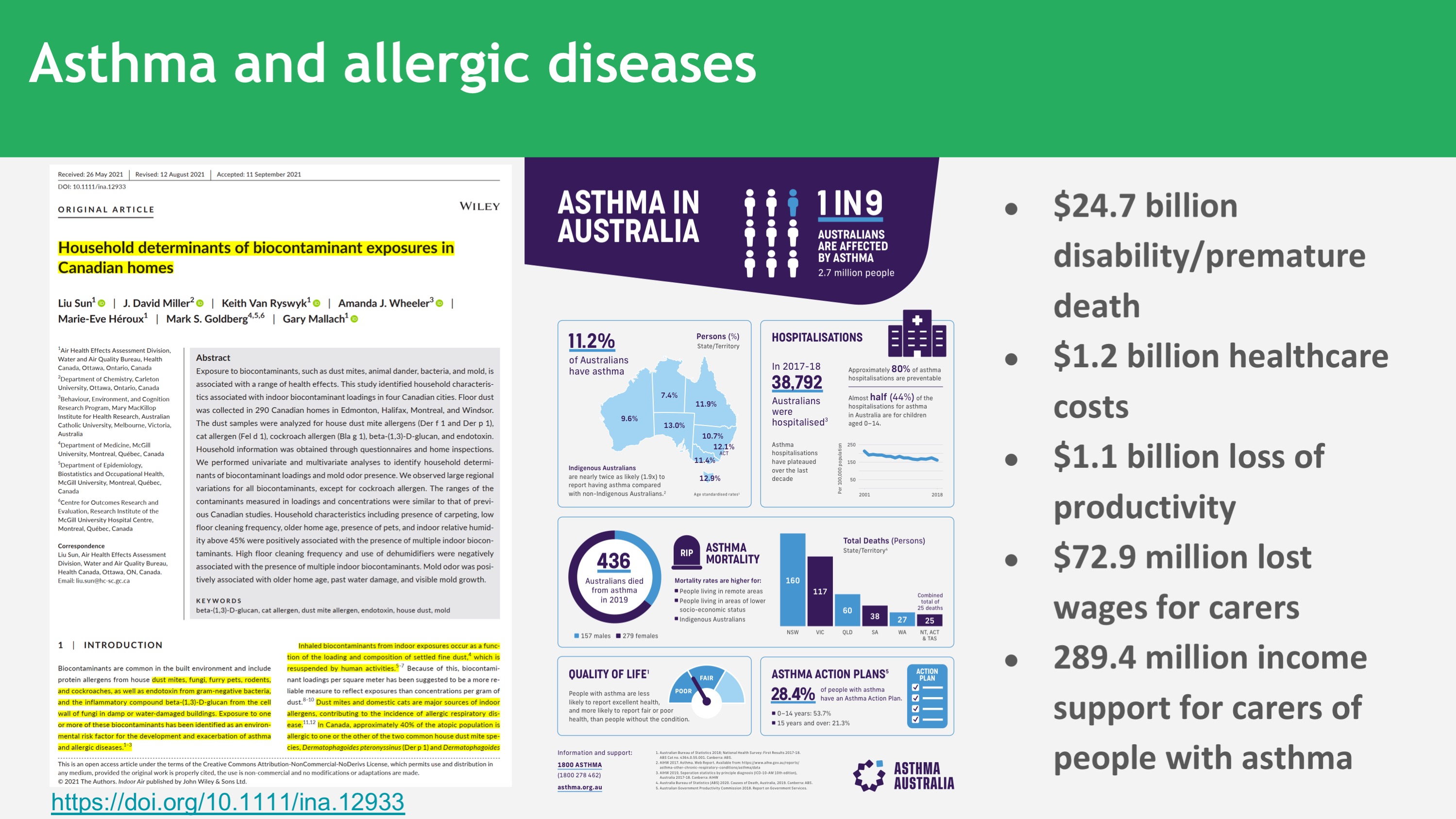Avoid the top 8 asthma and allergy triggers in your home

Hello. My name is Dr. Cameron Jones and I'm an environmental microbiologist and public health scientist. And this week we're going to be going over allergic illness and asthma.
In Australia, one in nine people is affected by asthma. And whenever I do indoor air quality and water damage and mold inspections, I'm always looking for those features inside people's homes and offices, which could contribute to adverse health. And a wonderful publication was just published at the end of September 2021, which was looking at this very problem. And today I'm going to be summarizing the research and also bringing to you a survey that you can take. It's for free. It's available on my website and also in a hyperlink in the show notes. And you'll be able to assess your own risk around the home yourself. But what are we talking about? What is asthma? Well, asthma really is a problem affecting your airways, meaning that it is difficult to breathe. And anyone who has seen an asthmatic having an asthma attack knows that this is very distressing and contributes in many ways to adverse health, and we'll be going through some of these key facts and figures today.
So the publication that I want to review is entitled: Household determinants of biocontaminant exposure in Canadian homes. Now don't worry, just because the publication was in Canada, these results translate here to Australia because there are some generic recommendations that I want to highlight today. But before I do that, I want to premise this presentation by reviewing some of the statistics for asthma in Australia. And it affects one in nine Australians. That is 2.7 million people. And there is a significant impact on the healthcare system and the costs associated with premature death and disability amount to 24.7 million per annum. There are also losses to productivity, lost wages due to carers, and income support needed for people who are caring for those with respiratory issues, which include asthma.

Now it's not just the fact that it's trouble breathing and has a big impact on the healthcare system. For those individuals who are suffering from these allergic responses to things in their environment, you got to remember that this is a preventative illness and the scientists say that up to 80% of cases of asthma are preventable. You also have to be aware of the fact that those with asthma have a reduced quality of life and self-report questionnaires filled out by people with asthma and allergic disease show that they rate their quality of life at fair to poor. So what can you do to reduce your risk? Well, when we talk about asthma triggers, most of us would be aware of the iconic images of people with masks surrounded or with urban haze, pollution haze behind them. But it's not just urban haze which contributes to asthma. It's also the presence or absence of things inside our home.
So obviously bacteria, yeast, and fungi are significant triggers for people with an allergic response. But what about the presence or absence of animals? What about the presence or absence of dust? And we're going to be focusing exclusively on this topic today. And so what did these scientists do? Well, they obviously got a group of homes and they went into approximately 300 homes and they gave them a questionnaire and they also vacuumed to collect dust from rooms in the home to assess what the fraction of allergens present in that dust was. And so that was how they undertook the research here. And they were looking at things like Beta 1-3D Glucan which is an inflammatory compound. They were looking for signs of water damage and mold. They were looking at how many pets are present in the home. And so all of these are potential triggers for those with asthma and allergic disease.
So what I've done is I've summarized this research. I'm presenting a short presentation now, but I have created a free survey that you can take and you can access this on my website and in the show notes, which will allow you to assess your own risk inside your own home. But I'm going to go through what these eight criteria or factors are so you can be aware of them and take note of them and then you assess the quantitative risk for yourself by doing the survey. So let's look at the first number one problem, and no, it's not the presence of the dog in the picture. It is the carpet and it's specifically how much carpet is present inside the home. And they found that carpeted homes and open plan living areas or main living areas with carpet are a significant contributor to biocontamination, which could then be linked to exacerbation of asthma and allergic disease.
Now, that all makes sense, but what happens if you don't have carpet? What happens if you've got hard floor coverings, timber floors, or tiled floors? Well, it turns out that you need to clean these regularly and they discovered that this needs to be done at least once per week or four (4) floor cleaning episodes per month was correlated with a reduction in triggers for asthma. Now, does the age of a home contribute to risk? Well, the research from Canada says yes, and those homes built before 1990 are overwhelmingly shown to have dilapidation or decay, which can contribute to conditions that exacerbate asthma. So certainly in all the water damage and mold assessments that we do here in Australia, I find that high energy rating homes and often new homes, lightweight construction homes have serious problems often due to concealed guttering and thin plasterboard, which when it gets wet, causes all sorts of problems.
But for the purposes of the survey and being faithful to the research findings, they found that homes built before 1990, older homes are more prone to having problems. And so you should bear that in mind. Now, having a cat might be a really good thing for having a pet, and pet ownership is definitely linked to having depression and feelings of wellbeing. But having a cat also means that the allergens coming out of the cat, that is the Fel D1 allergens are a significant risk factor and a lot of these allergens persist in your home for long periods of time. So if you've got a cat, that is a higher probability of having problems from asthma. The next risk factor is the amount of relative humidity present inside the home. And I always am on the lookout for high relative humidity inside properties because it is connected to the ability for water to form condensation out onto solid surfaces.
So you want to maintain your indoor relative humidity under 45%. And this is what one of the key findings from this publication was. And if you don't know what your relative humidity is, you can purchase inexpensive senses online or from electrical retailers and you're able to then track this yourself very much like a smartwatch/phone app. And I encourage anyone who is bothered by condensation, they really need to jump on and be proactive about monitoring the relative humidity inside their property. Now, the next problem inside homes relates to water damage and mould, and obviously, the age of the property and the condition of the property contributes to this. But you need to be aware that if there is a mold odor, there is decay going on. And so I chose this particular image because it highlights the fact that water damage could affect your wall floor or ceiling linings.
They don't need to look as serious as this for there to be an underlying problem. And if moisture accumulates on porous and semi-porous building material, that's a bad sign. So if you can see mold, that's an even worse sign. But the first one is can you smell mold? Because if you can, there is definitely a hidden mold reservoir and it may even be a known mold reservoir inside your home. The next criterion that you need to be aware of is the presence of insects like cockroaches. Cockroaches have an allergen called Bla G1 and these are notorious for triggering people's allergies and asthma. And just like the endotoxin present in mold, this is a toxin and it is present in the cell wall of fungi. And all of this becomes liberated into the airspace or deposits out onto surfaces. And what do I mean by depositing out onto surfaces?
Well, the amount of dust in your home is a leading indicator for the triggering of asthma. And it doesn't have to be as visible as this for there to be a problem, but you need to be aware of hard-to-clean areas in your home. And the fact that this dust presents with all sorts of different contaminants; these biocontaminants that I've been talking about, the cat and dog allergens, the endotoxin. And this is a really significant issue that we all need to be aware of. Because as I mentioned, asthma in many respects is to some extent preventable by reducing the exposure threshold to these biocontaminants. So in summary, we have eight things that we can control. You need to control your presence of carpeting, how often you clean it. You need to be mindful if you live in a home built before 1990. If you have cats and dogs, you need to be aware that those cats and dogs release allergens and that this is going to be a potential trigger for you. So you need to clean regularly.
You want to maintain your relative of humidity to be really less than 45. Once your relative humidity gets beyond 60%, that's a real problem. If there's any mold odor in the home, that is a dead giveaway that there is really living things on your porous and semi-porous materials. Cockroaches and dust also need to be looked out for. Now, I said to you that I was going to present you with how you can do the survey yourself because all of us want to be engaged with our wellbeing. And so again, you'll be able to click through in the show notes or you can take a screenshot of this, and this will link you directly to a short survey that I've created for you which will, in many cases, hopefully, help you identify those risk factors for exacerbation of asthma and allergic disease. Because at the end of the day, anything that can improve our wellbeing is a good thing. Anything that reduces the impact of an allergic or an immune response is a good thing for our overall health and wellbeing.
In any case, my name's Dr. Cameron Jones. I will be back next week talking about more research breakthroughs from the literature which impact on your home and health. Have a safe week. Bye for now. See you next time. Bye.
You can take the survey below or share it with the QR Code:

https://drcameronjones.checkboxau.com/Asthma-and-Allergy-Triggers
REFERENCES:
Sun L, Miller JD, Van Ryswyk K, et al. Household determinants of biocontaminant exposures in Canadian homes. Indoor Air. 2021;00:1–11. https://doi.org/10.1111/ina.12933

